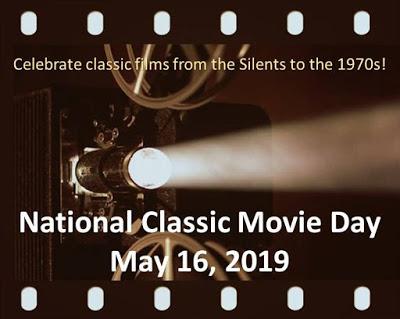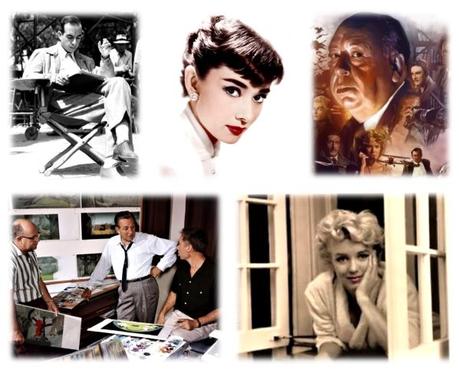
The Final Five
Who among committed classic film bloggers could possibly resist the chance to join a blogathon honoring National Classic Movie Day? I couldn’t, but this year’s blog-fest posed a tough challenge.
The Classic Film and TV Café aka/Rick, its founder, is once more hosting a National Classic Movie Day Blogathon. This year participants were challenged to choose and elaborate on their five favorite films of the ‘50s. Only five. From the ‘50s. Impossible. I made the effort and eventually whittled my list down to 10 or so films, but other titles continued to pop into my head, so I decided to go at it from another angle.
What I’ve done is take a look at the films of two popular stars, two filmmakers and a studio that were all at their peak during the decade and then selected one favorite from each out of their 1950s filmographies. Here goes…
Vincente Minnelli: The Bad and the Beautiful (1952)
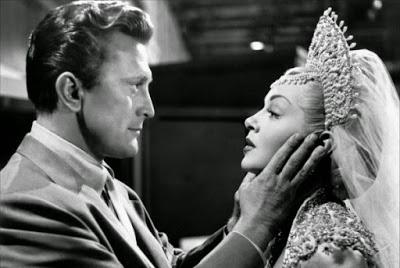
Kirk Douglas and Lana Turner in The Bad and the Beautiful
Vincente Minnelli broke out as a Hollywood director in 1944 with Meet Me in St. Louis, the biggest movie of the year. He would have his hits and misses during the ‘40s, directing a mixed bag of films in a mix of genres, including the romantic drama The Clock (1945), Yolanda and the Thief (1945), a musical, the noir drama Undercurrent (1946), The Pirate (1948), another musical, and an adaptation of Madame Bovary (1949). The 1950s would bring his greatest achievements and many of his films, also in a mix of genres, are, along with being bona fide classics, favorites of mine: Father of the Bride (1950), An American in Paris (1951), The Band Wagon (1953), Gigi (1958) and Some Came Running (1958).
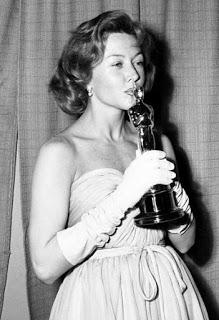
Gloria Grahame with her Oscar
I chose The Bad and the Beautiful (1952) as my top Minnelli pick of the ‘50s. Told in a series of three separate and individual flashbacks, it’s a Hollywood movie about Hollywood, from the town’s early days to mid-century. A sumptuous film – among the five Oscars won are those for costume design (Helen Rose) and art direction (110 sets were used, 10 for scenes within scenes) - it is strewn with a slew of references to movie insider knowledge and private jokes. Kirk Douglas, in a star-making turn, portrays a charismatic producer in the vein of David O. Selznick, with hints of Darryl F. Zanuck and Orson Welles; a scene following a fatal plane crash mirrors Clark Gable’s reaction when his wife, Carole Lombard, was lost in a similar tragedy; elements of Lana Turner’s character are said to be based on John Barrymore’s daughter, Diana. And more. Then there’s Gloria Grahame in her Oscar-winning supporting performance as the seductive southern belle wife (Zelda Fitzgerald?) of a novelist-turned-screenwriter (Dick Powell). When Gloria’s on the screen she lights it up with a sparkle and glow like no other, and The Bad and the Beautifulis a film that glitters all the more radiantly with her presence.The Bad and the Beautiful is a big, brash melodrama about Hollywood movers and shakers and how movies were made in earlier days. The performances are big, the sets are sometimes mammoth, and the story itself is vast in its scope. All of this is powerfully enhanced and accentuated by one of the greatest of all film scores, the work of legendary composer David Raksin, who also scored Laura in 1944 and would be Oscar nominated for Forever Amber (1947) and Separate Tables (1958). Raksin deserved the Oscar for his score for this one; The Bad and the Beautiful, one of the very best and most successful films of 1952, would’ve been quite a bit less beautiful without his music.
Watch the trailer, hear the score...
Audrey Hepburn: Roman Holiday (1953)
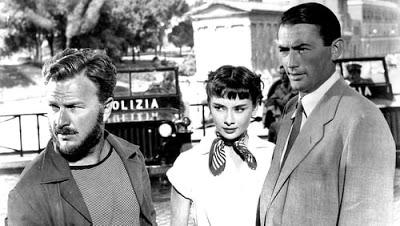
Eddie Albert, Audrey Hepburn and Gregory Peck in Roman Holiday
Audrey Hepburn stepped onto the world stage in 1953 with her first starring film role as Princess Ann in William Wyler’s Roman Holiday. She would take the Best Actress Oscar for her performance and go on to star in two Billy Wilder films, Sabrina (1954) and Love in the Afternoon (1957), during the ‘50s, Funny Face (1957) for Stanley Donen, and The Nun’s Story (1959) for Fred Zinnemann; she would earn Best Actress Oscar nominations for Sabrina and The Nun’s Story. She would continue her rise through the 1960s with performances in films like Breakfast at Tiffany’s (1961), Charade (1963), My Fair Lady (1964), How to Steal a Million (1966), Two for the Road (1967) and Wait Until Dark (1967). She was Oscar nominated for Breakfast at Tiffany’s and Wait Until Dark. At this point she would take a break from acting and embrace motherhood, not returning to the screen until 1976. She would make only five more films prior to her death in 1993. By then she was a legend – as an actress, a style icon and a humanitarian.
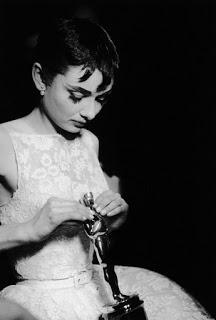
Audrey Hepburn with her Oscar
So. Roman Holiday. Why? To begin with, this is a treasure of a film, William Wyler’s romantic postwar-modern fairytale about a runaway European princess and an American “commoner” (Gregory Peck) who teeter on the brink of love and, after a fleeting few days of adventure, come to a wistful, bittersweet goodbye. The film deservedly earned a Best Picture nomination, as well as nine more, including three wins. One of these justifiable wins was for the screenplay and given to Ian McLellan, who was fronting for Dalton Trumbo (Kitty Foyle/1940, Spartacus/1960, etc.), who was then on the blacklist. In 1993 McLellan’s name was removed and the award credited to Trumbo. Gregory Peck is perfectly cast as the journalist torn between getting the big story and hanging onto his integrity, and second lead Eddie Albert provides a good dose of affable comic relief.There are so many reasons to favor Roman Holiday, one of the best romantic comedies of the 1950s. But I chose it mostly because of Audrey Hepburn. I suppose it would’ve been possible at the time for another young European actress, one with similar film experience, to have been given the role. For example, gamine Leslie Caron, a gifted actress from France, who had already made an impression with An American in Paris. Or, perhaps, delicate Pier Angeli, from Italy, who was, like Audrey, emerging in the early ‘50s. Either of them, or another, might’ve been fine as the princess and the film still might’ve worked well. But with Audrey Hepburn in the role, Ann is the most beguiling of ingenues. Being of Old World royalty, she would certainly have been a young lady of refinement and elegance. But the combination of curiosity, tenderness and vivacity that Audrey brings to the character, along with her own understated glamour and elfin charisma, make for a completely enchanting Princess Ann. It was the best possible career launch for the actress and an ideal introduction for movie-goers to the magic of Audrey Hepburn.
Roman Holiday - The Mouth of Truth
Alfred Hitchcock: Rear Window (1954)
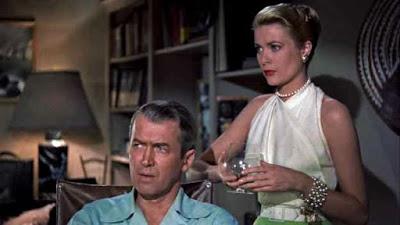
James Stewart and Grace Kelly in Rear Window
The 10 years spanning 1951 – 1960 encompassed Hitchcock’s “Golden Decade.” It began with Strangers on a Train (1951), ended with Psycho (1960), and included Rear Window (1954), Vertigo (1958) and North by Northwest (1959), to mention the rest of Alfred Hitchcock’s 1950s crème de la crème. Truthfully, it would be impossible for me to pick a favorite between Strangers, Rear Windowand Vertigo. And so, continuing to be honest about it, I chose Rear Windowbecause it is the only film among “the cream” that I haven’t blogged about yet.
Alfred Hitchcock spoke passionately of “pure cinema,” the technique of relating a story visually, through cinematography, editing and sound design with less emphasis on dialog. He was a master of the art and the best of his films offer viewers a chance to participate in an immersive experience by way of his brilliant, in his words, “juxtaposition of pieces of the film.”
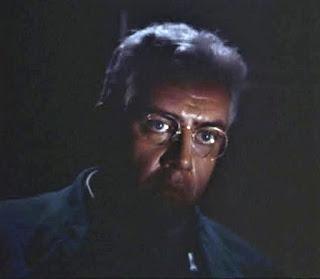
Raymond Burr in Rear Window
Rear Window is one of Hitchcock’s most effective exercises in pure cinema. The story concerns a man, Jeff Jeffries (James Stewart), who is wheelchair-bound in his oppressive apartment, convalescing with a broken leg. He is confined to this room throughout the entire film. He gets bored and begins looking out the window of his rear-facing apartment into the windows of his neighbors – with the help of a pair of binoculars. He becomes suspicious of what’s going on in an apartment directly across from his and begins to conspire with friends and associates (Grace Kelly, Wendell Corey, Thelma Ritter) to do some snooping. In other hands this kind of story could end up looking like a filmed single-set stage play. Rear Window is anything but that. It opens with a leisurely panning shot that takes in the scene of the various apartments and neighbors Jeff will be observing once he picks up his binoculars. The camera then sweeps through the main room of his apartment, pausing on objects that explain the man who lives there – a magazine journalist who has broken his leg on assignment. And it is a very hot day…In a 1963 interview with Cinema magazine, Hitchcock described Rear Window as “very cinematic” despite the central character being static, “in one position, in one room, for the whole picture.” He talked about how close-up shots of James Stewart’s facial expressions were edited with shots of images he observes as a means of manipulating audience acceptance of his character. Naturally, Stewart’s character, Jeff, is very likeable and easily related to by viewers. It is through a continuing series of point-of-view shots, especially those depicting what Jeff sees with his binoculars, that the audience is swiftly maneuvered into sharing his perspective and his anxieties.
Rear Window is technically superb and enormously enjoyable. Along with Hitchcock’s visual pyrotechnics (Robert Burks, D.P.), the film features a sharp script by John Michael Hayes (his first of four for Hitchcock), with three old pros (Stewart, Thelma Ritter, Wendell Corey) and one newly minted pro (Grace Kelly) to handle clever character-defining dialog. Raymond Burr doesn’t have much to say as the villain of the piece, but he’s goosebump-inducing scary in his climactic scene with Stewart.
What more can I say? Rear Window is a masterpiece I’ve seen countless times with more viewings to come.
Rear Window, opening scenes
Walt Disney Productions: Lady and the Tramp (1955)
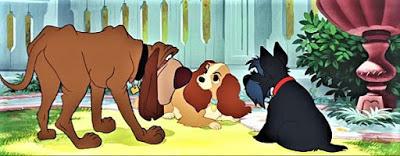
Trusty, Lady and Jock in Lady and the Tramp
The Disney zeitgeist enjoyed a colossal heyday during the 1950s. An entire generation of Americans, the Baby Boomers, was mesmerized by a series of Disney animated features, nature documentaries, live action feature films and its Mickey Mouse Club on TV.
Disney animation produced Cinderella (1950), Alice in Wonderland (1951), Peter Pan(1953), Lady and the Tramp (1955) and Sleeping Beauty (1959). From the documentary side came The Living Desert (1953) and The Vanishing Prairie (1954). Feature films included Treasure Island (1950), 20,000 Leagues Under the Sea (1954), Davy Crockett: King of the Wild Frontier(1955), its sequel Davy Crocket and the River Pirates (1956), Old Yeller(1957), The Shaggy Dog (1959) and Darby O’Gill and the Little People(1959).
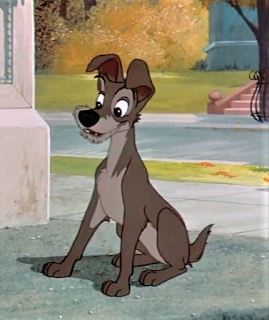
The Tramp
So much great entertainment to choose from…Peter Pan, 20,000 Leagues, Old Yeller, The Shaggy Dog. But this choice was not so difficult, even with such an embarrassment of Disney riches to choose from. For me, it’s Lady and the Tramp, a colorful, heartwarming dog fairytale. Princess dog (Lady, a Cocker Spaniel) meets commoner dog (the Tramp, a homeless mutt) and their opposites-attract chemistry eventually leads to love. The dogs will contend with hardship and adversaries - a dog-hating aunt and her mischievous Siamese cats (“We are Siamese if you pleeease…”). Ultimately, though, they will end up heroically saving the day and be allowed to live happily ever after with Lady’s owners, “Jim Dear” and “Darling.” It’s adorable.Legendary songstress Peggy Lee voiced the roles of Darling, the two cats (Si and Am) and Peg, a stray Pekingese who sings “He’s a Tramp,” an apparent allusion to her ex, Lady’s newfound beau. Other dog characters who help Lady and the Tramp include Jock, a neighborhood Scottie, and Trusty, a bloodhound who was once a tracker but has lost his sense of smell. It’s adorable.
Dinner at Tony's
Marilyn Monroe: Some Like it Hot (1959)

Joe E. Brown and Jack Lemmon in Some Like it Hot
The 1950s were also Marilyn Monroe’s zenith years. She’d been only a starlet in the late ‘40s, with minor roles in minor films, and she lived not very far into the ‘60s. Throughout the ‘50s, however, she was a comet ablaze on silver and Technicolor screens around the world. A superstar.
She started the ‘50s with small roles in two classics, John Huston’s The Asphalt Jungle (1950) and Joseph L. Mankiewicz’s All About Eve (1950). Lesser films continued but, thanks to Howard Hawks and Gentlemen Prefer Blondes (1953), she was able to demonstrate her gift for comedy and shoot to the stratosphere in the glittery role of a dizzy but good-hearted showgirl, Lorelei Lee. Later that year she co-starred with Lauren Bacall and Betty Grable in another huge hit, How to Marry a Millionaire, playing a near-sighted Lorelei Lee type. By the time she made The Seven Year Itch (1955) for Billy Wilder, she no longer needed big name co-stars to help attract a wide audience, she was a phenomenon. At this point Marilyn Monroe wanted to prove herself as a serious actress and so she next appeared in Bus Stop (1956), a William Inge drama directed by Josh Logan. She would finish the decade working with Billy Wilder again, this time on his comedy masterpiece Some Like it Hot (1959).
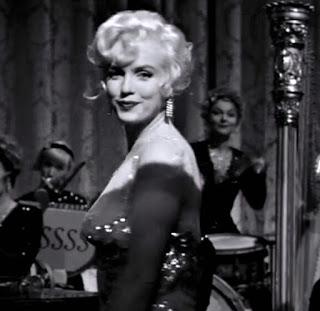
Marilyn Monroe as Sugar Kane
My Marilyn Monroe pick has to be Some Like it Hot, a flawless film. Penned by Wilder and his writing partner Izzy Diamond, a pair that produced some of the smartest, snappiest and most worldly screenplays ever, Some Like it Hot is classic screwball. Its multi-themed story line is pure farce, the dialogue, running at break-neck pace, boasts hilariously witty repartee, and there is more than one wacky romance at play.In 1929 struggling musicians Joe (Tony Curtis) and Jerry (Jack Lemmon) have the misfortune to witness an infamous gangland massacre on St. Valentine’s Day. Desperate to get out of town incognito and fast, they deck themselves out in drag and head for Miami with Sweet Sue’s all-girl band. On the train south they meet the band’s luscious singer, Sugar Kane (Marilyn Monroe). Both men are smitten but Sugar only thinks of them as what they seem to be, gal pals. The plot goes wild once they reach Miami and Joe (now Josephine) connives to meet and seduce Sugar by way of a more masculine alter ego, and Jerry (now Daphne) struggles to deal with the love interest he’s managed to attract. And there’s the arrival of the mob to contend with. The roles of Joe/Josephine, Jerry/Daphne and Sugar Kane give the actors – Curtis, Lemmon and Monroe – showcases to die for. And each of them delivers and then some. Directing Marilyn was a task that tested Wilder to the limit. But he was convinced that if he could be patient enough to coax it out of her, he’d get the performance he wanted. And he did.
Tony Curtis was on a roll when he came to Some Like it Hot. He’d had a solid hit with Trapeze (1956), co-starring with Burt Lancaster and Gina Lollobrigida. Perhaps his best film and juiciest role to-date had been in Sweet Smell of Success (1957), again with Lancaster. And he'd earned an Oscar nomination more recently with The Defiant Ones (1958), a race-themed drama opposite Sidney Poitier. Curtis would be in even greater demand after Some Like it Hot, having just given a top-flight comedic performance on a par with his two sizzling co-stars in one of 1959's biggest hits.
Glancing at Jack Lemmon’s filmography, one sees that Some Like it Hot shifted him from supporting to leading roles. He’d won a supporting Oscar a few years earlier for Mister Roberts (1955) but was nominated in the Best Actor category for the first time with Some Like it Hot. He would be nominated in that category again for Wilder’s The Apartment (1960) and be nominated six more times, winning for 1973’s Save the Tiger. He was on fire in Some Like it Hot as Jerry/Daphne and had the good fortune to share one of the best and most famous closing scenes in film history when, speeding in a motorboat with Osgood (Joe E. Brown), his suitor, he decides to come clean. Osgood has proposed marriage and isn’t accepting any of Jerry/Daphne’s lame reasons for refusing him. Finally, as he tears the ladies wig he’s wearing from his head, Jerry/Daphne’s voice drops to its normal register with the exclamation, “Oh, you don’t understand, Osgood, I’m a man!” To which Osgood smiles a broad smile and replies quite calmly, “Well, nobody’s perfect.”
"How do they walk in these things?"~
Click here to go to The Classic Movie and TV Café and links to the blogs participating in the National Classic Movie Day Blogathon.
